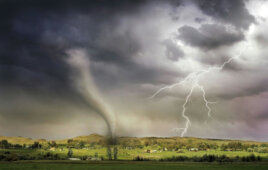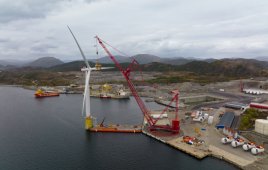A 3.5kW vertical-axis wind turbine is said to produce clean, reliable energy for residential and commercial applications. The system can mount on flat rooftops, as well as traditional towers and poles. The V3.5 from Cleanfield Energy, Ancaster, Ontario, Canada, can be installed without the need to change existing wiring, and can be used for both grid-tie and off-grid applications.

3.5 KW turbine with smart technology
The design has three major components – turbine, generator and inverter – that are said to have features customized by the company. The firm says its modifications allow for maximum efficiency and reliability.
Cleanfield says the turbine has few moving parts to provide good reliability while the stationary center structure can accommodate grounding for lightning protection.
The turbine’s high aspect ratio accommodates its low nominal rotation speed. As a result, a low blade-speed ratio (ratio of blade speed to wind speed) minimizes audible noise. The blades connect to the shaft with two struts for a low-loss aerodynamic profile, which contributes to a better power coefficient.
The turbine comes with a custom-developed sensor and interface board which communicates with the inverter for data collection, supervision, and protection of the hardware. This feature extends the unit’s life expectancy and lowers maintenance costs. The sensor board monitors turbine vibration for resonant frequency skipping and to shutdown the turbine should sensors detect excessive vibration. Thermal sensors monitor generator temperature so controls can reduce its output power and eventually shut it down when it approaches the thermal operating limits. The unit will not start if the outside temperature drops below -40C. This prevents bearing damage. An electromechanical brake ensures a controlled stop and limits the turbine speed to ensure it operates within safety limits and max efficiency.
The direct-drive generator works at low speed because of its permanent magnet design. The external rotor matches turbine parameters, such as nominal rotational speed, nominal torque, and assembly requirements. The generator is built into the system structure.
A fail-safe electro-mechanical brake with status feedback must be energized for release and so engages in a power loss. Shutting down the power stops the turbine from spinning and also lets service and maintenance work proceed safely.
The inverter uses a custom algorithm to control the generator. The flux-vector-control software provides a way to monitor voltage, frequency, and current without costly and unreliable external sensors. The software can also profile and predict patterns and conditions.
The rotor is controlled by regulating current to and from the generator. The control algorithm allows variable-speed operation so the generator delivers optimum power while staying within safety limits. As a result, even in gusty or high winds, the turbine speed will not exceed 160 rpm. The table includes a few more particulars.
Filed Under: Components, Featured, Sensors




